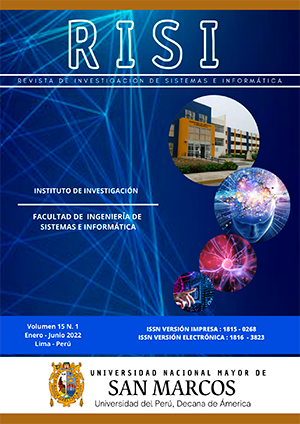Ontology for monitoring higher education graduates through protégé software
DOI:
https://doi.org/10.15381/risi.v15i1.23423Keywords:
Ontology, Classes, Instance, Curriculum, GraduateAbstract
The use of emerging technologies has acquired special relevance in different areas, especially in education and the academic sector. The research is oriented towards the achievement of new knowledge in a systematic and verifiable way. Objective: To build, through software, an ontology for the follow-up of higher education graduates. Methodology: A non-experimental design was used, cross-sectional, descriptive level and with a qualitative approach, whose purpose is to build a product (the ontology of higher education graduates). It begins by designing a model of the ontological process, specifying the concepts in order of relevance within the academic area, such as the study plan, areas of knowledge, interest groups, etc. Collecting them inside the ontology editor called Protégé, used for the construction of intelligent systems. The graduates of the first promotion of the Professional School of Statistics and Informatics of the Faculty of Sciences were taken as reference. Results: Starting with the descriptive information of the data, it was concluded with an ontology prototype oriented to the follow-up of the graduate, starting from the study plan, ending in a conceptual model that interrelates all the components up to the graduate. Conclusions: The respective ontology was built within the software, for this purpose 34 classes were built, of which 5 correspond to the higher level, for which the technical evaluation was included, creating instances of the teaching class, courses, graduates interest groups, etc.
Downloads
Downloads
Published
Issue
Section
License
Copyright (c) 2022 Gustavo Adolfo Escalante Febres, Miguel Angel Aguilar Luna Victoria, Augusto Parcemon Cortez Vásquez

This work is licensed under a Creative Commons Attribution 4.0 International License.
AUTHORS RETAIN THEIR RIGHTS:
a. Authors retain their trade mark rights and patent, and also on any process or procedure described in the article.
b. Authors retain their right to share, copy, distribute, perform and publicly communicate their article (eg, to place their article in an institutional repository or publish it in a book), with an acknowledgment of its initial publication in the Revista de investigación de Sistemas e Informática.
c. Authors retain theirs right to make a subsequent publication of their work, to use the article or any part thereof (eg a compilation of his papers, lecture notes, thesis, or a book), always indicating its initial publication in the Revista de investigación de Sistemas e Informática (the originator of the work, journal, volume, number and date).


